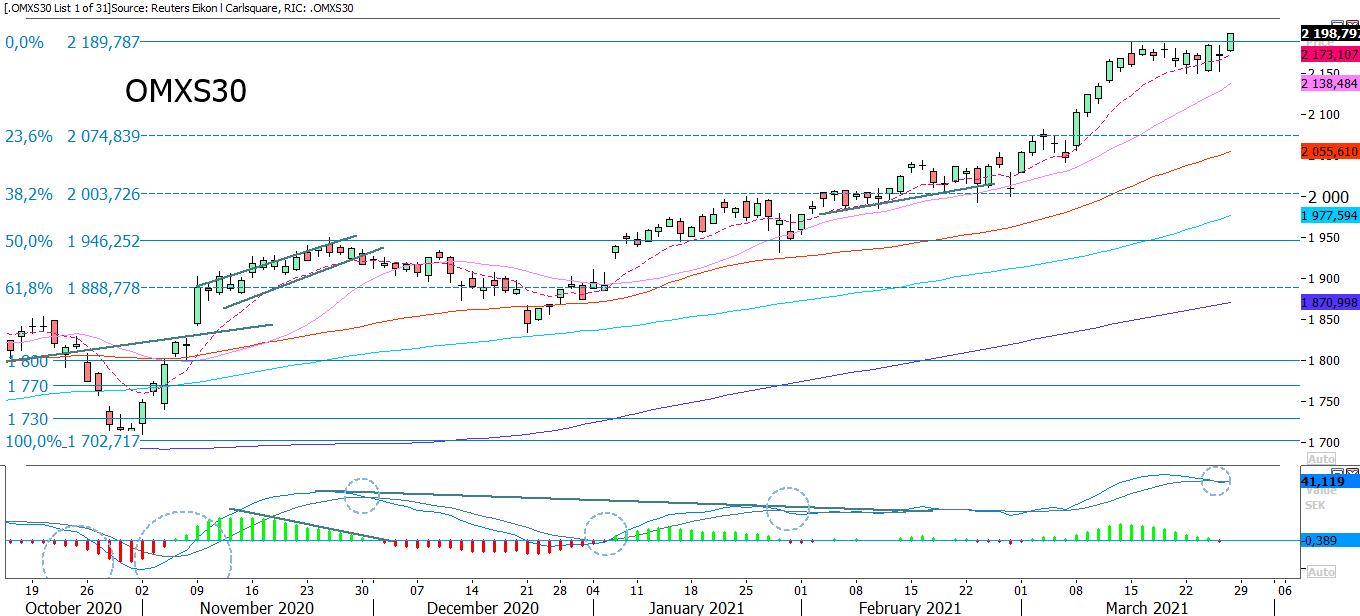Are the pessimists giving up?


The pessimists are starting to throw in the towel. The ongoing stock market rally really hurts the pessimists who warn of an impending crash. The easiest way is to look at VIX, which reflects the market´s expectations of volatility over the next 30 days.
The pessimists are starting to throw in the towel. The ongoing stock market rally really hurts the pessimists who warn of an impending crash.

The easiest way is to look at VIX, which reflects the market´s expectations of volatility over the next 30 days. On Friday alone, VIX fell by 4.8 percent. The best timing to buy VIX is when it starts flirting with the lower Bollinger bands. Purely mathematically, this occurs at 2 standard deviations from the 20-day average. It is a level that indicates that the pessimists are giving up and starting to join the rank of optimists. That is when it is time to buy cheap protection in the market.

An ever-better way to reflect this is in the graph above which shows assets in the ETF SH. This ETF should mimic the S&P 500 index, though inverted. That is – when the S&P 500 rises, it will fall, and vice versa. The red line shows the rise in the S&P500 index. The blue line shows the assets invested in this ETF. Note how this exploded when the S&P 500 fell in connection with the initial phase of the Covid-19 pandemic. But now the money is being withdrawn from this ETF as the S&P 500 index appears to be only rising further upwards.

This is what a murderous trade looks like. It is SH (short S&P 500) in year and a half. Note that the old rule of only owning assets that are above MA200 is completely valid for this graph.

It is not so strange that the pessimists are close to having to display the white flag. The above shows the rapid rise in the M2 in the United States, i.e., the best measure that the Fed is comfortable to show as the measure of the money supply. M2 shows cash and financial instruments that can quickly be converted into cash. The Fed is sitting on much better tools that also illustrates the total credit growth, which is a much better measure. But this is not something that the Fed likes to show.
But outside of M2 and credits, other asset classes are also being created. The most well-known example is of course Bitcoin which adds to the money supply.

As shown in the graph above, Bitcoin bounced of MA50 and is currently struggling to retake MA20. Note the negative divergence between Bitcoin and MACD that may be somewhat worrisome.

https://www.designboom.com/art/what-is-nft-why-non-fungible-art-marketplace-millions-04-06-2021/
In extension of Bitcoin, the prices of NTFs (non-fungible tokens), which are digital works of art, uniquely marked with blockchain technology, are exploding. So far, we have not seen anyone who has tried to include the importance of this type of asset in the money supply, but the relationship is clear. At the end of all upturns, interest spills over from the stock markets to the periphery as the market looks for new places to receive return on its capital. After last year’s stock market rise, it is not realistic that it will be surpassed this year, no matter how much money the central banks push into the system. Instead, the money goes to the wine and arts market.
Regardless of how much Bitcoin enthusiasts argue that this is a new asset class being an alternative to the regular money system, it is only a part of it. This will be proven on the day the stock markets crash. We find it very difficult to see where and how to protect ourselves against future asset price changes, except in cash (M2).

P/E-ratios are now at extreme levels.
But why be bored and talk about crashes when everything rises? On Friday, the Fed decided that the temporary halts to dividends and repurchases will be abolished from June 30, 2021. Corporate repurchases of own shares have been one of the major driving forces behind the rise in the stock market. In the absence of genuine growth, US companies have put in place systems to increase loans and use the funds to buy back their own shares. This gives an artificial increase in earnings per share, which is the overall measure of a company´s success on the stock exchange. A higher earnings per share depresses the P/E-ratio, which causes the computers to buy the share when they identify a favorable valuation relative to its peers.

There is really reason for the stock market to cheer over this news. This was reflected in a rally during the last hour’s trade on Friday 26 March.
To date, 12 of 504 S&P 500 companies have reported their Q1 2021 results. 83 percent have surprised positively compared to the stock market’s expectations. Of the four companies that reported last week, Adobe is the most well-known and managed to outperform analysts’ earnings forecasts by 4 percent.

Concerns about rising interest rates rightly remain. What the stock market hates, however, is not rising interest rates, but suddenly rising interest rates. The interest rate level we have today is artificially low. No one would more than us applaud a revert to more normal interest rates.

The graph above shows that the Fed has succeeded in making the market believe that the real interest rate may end up around zero in the coming years, despite all the liquidity being pushed into the market.
In terms of the global stock market indices, it is a continued rise, while the emerging markets continue to struggle. These are traded much like the tech sector. This indicates that the stock market’s investors are looking for value stocks, but commodity shares are also on the rise.

As we suspected, there was a buying opportunity when the S&P500 index tested the rising trend line. It is important for the trend that a new high is set during this wave if upwards movement. But the negative divergence with MACD is again somewhat worrisome:

The tech heavy Nasdaq index bounced nicely on Friday of MA100. MA50 is the next level on the upside. However, a continued rotation out of growth stocks into value stocks may also continue to hurt Nasdaq, relative to the S&P 500 index:

We continue to view Apple more as a value company than a growth company. Note how the stock appears to be sliding around the MA200 and that the MACD is starting to turn upwards.

Mini Futures
The Tesla share is again under pressure and pushed downwards by MA20 towards Fibonacci 50. A break on the downside and the 550 USD-level may be next:

Interesting is how the Shanghai Stock Exchange has gone against the rest of the world. Is it a double bottom just above the MA200 that has been created? It would be liberating if the Shanghai Stock Exchange index could also fall into the upswing of the rest of the world.

Given worries about increased Covid-19 restrictions, especially in Europe, the demand for USD has increased as a haven. Will the previous bottom from October 2020 be tested, or will the EUR/USD-quota of 1.175 hold?

European stock market indices such as the DAX and OMXS30 has clearly been favored by the rotation into cyclical stocks, such as industrials. On the other hand, a lack of semiconductors may be a short-term threat to industrial companies’ earnings. Below is a graph for the DAX index shown. The index gaped up on Friday 26 March, but did not manage to break up above its previous top from mid-March:

The OMXS30 index has been favored as it mainly consists of industrial stocks, but also banks that has gained momentum with rising interest rates. On Friday 26 March, OMXS30 also set a new all-time-high:

On the other hand, cost of inputs, such as copper and oil, is also increasing. The upcoming quarters may be interesting to see whether industrial companies will be able to push these increased costs on to their clients. But as shown in the graph below, price of brent oil may be on its way down and is currently trading just below the 65 USD per barrel-level. MA50 serves as support. In case of a break to the downside, Fibonacci 38.2 is the next level:

Risks
This information is in the sole responsibility of the guest author and does not necessarily represent the opinion of Bank Vontobel Europe AG or any other company of the Vontobel Group. The further development of the index or a company as well as its share price depends on a large number of company-, group- and sector-specific as well as economic factors. When forming his investment decision, each investor must take into account the risk of price losses. Please note that investing in these products will not generate ongoing income.
The products are not capital protected, in the worst case a total loss of the invested capital is possible. In the event of insolvency of the issuer and the guarantor, the investor bears the risk of a total loss of his investment. In any case, investors should note that past performance and / or analysts' opinions are no adequate indicator of future performance. The performance of the underlyings depends on a variety of economic, entrepreneurial and political factors that should be taken into account in the formation of a market expectation.